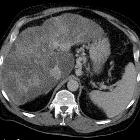abdominal manifestations of cystic fibrosis










Abdominal manifestations in cystic fibrosis (CF) are common, varied and nearly all organ systems can be affected, and it should be remembered that only 39% of patients with cystic fibrosis have pulmonary symptoms as their sole complaint . Not only that, but 7% of cystic fibrosis patients do not present until adulthood.
This article focuses on abdominal manifestations of cystic fibrosis. For general discussion of cystic fibrosis, and a discussion of its other manifestations, please refer to:
- cystic fibrosis (parent article)
Pancreatic manifestations
The pancreas is the most commonly involved abdominal organ in cystic fibrosis. Exocrine gland insufficiency affects 85-90% of all cystic fibrosis patients and results from inspissated secretions leading to proximal duct obstruction with subsequent acinar disruption and replacement by fibrous tissue and fat.
Endocrine dysfunction occurs in 30-50% of cystic fibrosis patients:
- fatty replacement
- most common manifestation of the pancreas
- can progress to complete pancreatic lipomatosis
- mean age is 17 years
- acute pancreatitis: occurs in patients with residual pancreatic exocrine function
- pancreatic calcifications occur in 7% of patients
- pancreatic cysts and cystosis: typically microscopic 3 mm diameter
- pancreatic duct strictures
Hepatobiliary manifestations
Liver parenchymal disease
- up to 72% of adult cystic fibrosis patients will develop liver disease
- focal biliary cirrhosis (pathognomonic for cystic fibrosis and present in 78%): focal portal fibrosis and cholestasis; thickened hyperechoic periportal tissue on ultrasound (>2 mm thickness)
- up to 12% progress to multilobular cirrhosis , but the development of hepatocellular carcinoma (HCC) is unusual
- 1-8% progress to portal hypertension
- hepatic steatosis (23-67% ; seen in 30% of cystic fibrosis patients at biopsy, 30-50% at imaging and 60% at autopsy)
- pathophysiology is multifactorial
Biliary tree
- gallstones: 12-24% of cystic fibrosis patients
- sclerosing cholangitis
- intrahepatic ductal strictures are seen in 100% of patients with cystic fibrosis and liver disease and may correspond histologically to focal biliary fibrosis seen in 78% of patients >24 years old
- microgallbladder: seen in up to 30% of cystic fibrosis patients at autopsy
Gastrointestinal manifestations
- gastro-esophageal reflux and associated complications such as Barrett esophagus: thought to be secondary to chronic cough, hyperinflation, and diaphragmatic depression
- gastric and duodenal ulcerations: likely related to impaired bicarbonate secretion
- distal intestinal obstruction syndrome (DIOS)
- intussusception: typically ileocolic and may result from adherent fecal residue or enlarged lymphoid follicles ; a chronically distended appendix may be the lead point
- despite the common distention of the appendix by inspissated secretions, the reported prevalence of acute appendicitis in cystic fibrosis patients is lower than that in the general population
- colon: often abnormal, with proximal colonic wall thickening, pericolonic fat proliferation, and mesenteric fat infiltration
- pneumatosis intestinalis: confined to the colon and typically coincides with the development of obstructive lung disease
- rectal mucosal prolapse: typically in young children in whom a diagnosis of cystic fibrosis has not yet been made or young adults that are noncompliant with treatment
- gastrointestinal tract malignancies: of which colorectal carcinoma is most common
Renal manifestations
- renal stones: symptomatic stones are twice as common in cystic fibrosis patients (~4.5%) compared to the general population (2%)
- nephrotic syndrome from secondary amyloidosis (poor prognostic sign)
Siehe auch:
- Pneumatosis intestinalis
- Leberzirrhose
- Nierensteine
- Kolorektales Karzinom
- portale Hypertension
- zystische Fibrose
- Invagination
- Pankreaslipomatose
- Akute Pankreatitis
- Pankreaslipomatose bei Zystischer Fibrose
- sclerosing cholangitis
- distal intestinal obstruction syndrome (DIOS)
- gastroösophageale Refluxerkrankheit
- pulmonale Manifestationen der Mukoviszidose
- small bowel involvement with cystic fibrosis
- fatty replacement
und weiter:

 Assoziationen und Differentialdiagnosen zu abdominelle Manifestationen bei Mukoviszidose:
Assoziationen und Differentialdiagnosen zu abdominelle Manifestationen bei Mukoviszidose:











